Drive-by botany: Golden Alexanders and Arrowwood viburnum
Profiles of common Michigan roadside flora in early June 2021.

Authors’ note: Drive-by botany is a continuing series that highlights flowering plants commonly seen from the road. As a service to new readers, we include the introduction with each article. If you're already familiar with the premise, feel free to skip down to the good stuff.
Has a patch of flowers ever caught your eye as you travelled down the road? It certainly happens to us all the time! As gardeners and naturalists, we're always interested in increasing diversity in our gardens, so we thought it would be fun to consider some of the roadside plants that we see every day and reflect on whether they would be good additions to a home landscape. Each article in this series will feature two plant species that are currently blooming and frequently observed from the road. Our goal is to answer two simple questions:
- What are they?
- Would they make good garden plants?
As part of the process, we'll include some biological tidbits and a few useful characteristics for identification. Please note that some of the plants we feature are exotic invasive species; we'll be sure to include recommendations from land management professionals on how to manage them in your landscape.
June 2021, East Lansing, Michigan – week 23, 1,606 growing degree days (GDD) base 32
Golden Alexanders (Zizia aurea)
Golden Alexanders is a member of carrot family (Apiaceae), a group of plants that contains many fragrant and palatable herbs. Despite the edible nature of many of its members, this family also has its fair share of species that are highly toxic to humans. The sap from some species, e.g., wild parsnip (Pastinaca sativa) and giant hogweed (Heracleum mantegazzianum), are known to cause plant-associated dermatitis with symptoms ranging from minor rashes to severe burns. Others are poisonous only when consumed. Poison hemlock (Conium maculatum), another a member of the carrot family, is believed to have killed Socrates.
Given the nature of this family, we recommend cautious handling with unfamiliar species and limiting consumption to known garden varieties.
Description
Flowers: Golden Alexanders flowers are bright yellow and are arranged in a circular cluster that has a flat or slight dome shape (Photo 2). The shape and structure of the flower cluster is very similar to that of Queen Anne's lace (Daucus carota, also in the carrot family). The flowers are the most easily recognizable feature of this plant.
Leaves: Like nearly every other species in the family, Z. aurea has compound leaves with serrated margins, giving it the typical appearance of a member of the Apiaceae.
Quick definition: A compound leaf consists of multiple smaller leaflets that are all connected to a single stalk (also known as a petiole) which is, in turn, connected to a larger stem. Some plants have leaves that can be two or three times compound.
Seeds/fruit: Elongated seed capsules replace the flowers later in the season and are typically 0.1-0.2 inches long. The seed head retains the same flat circular structure as the flowers (Photo 3).
Height: Typically 12-36 inches
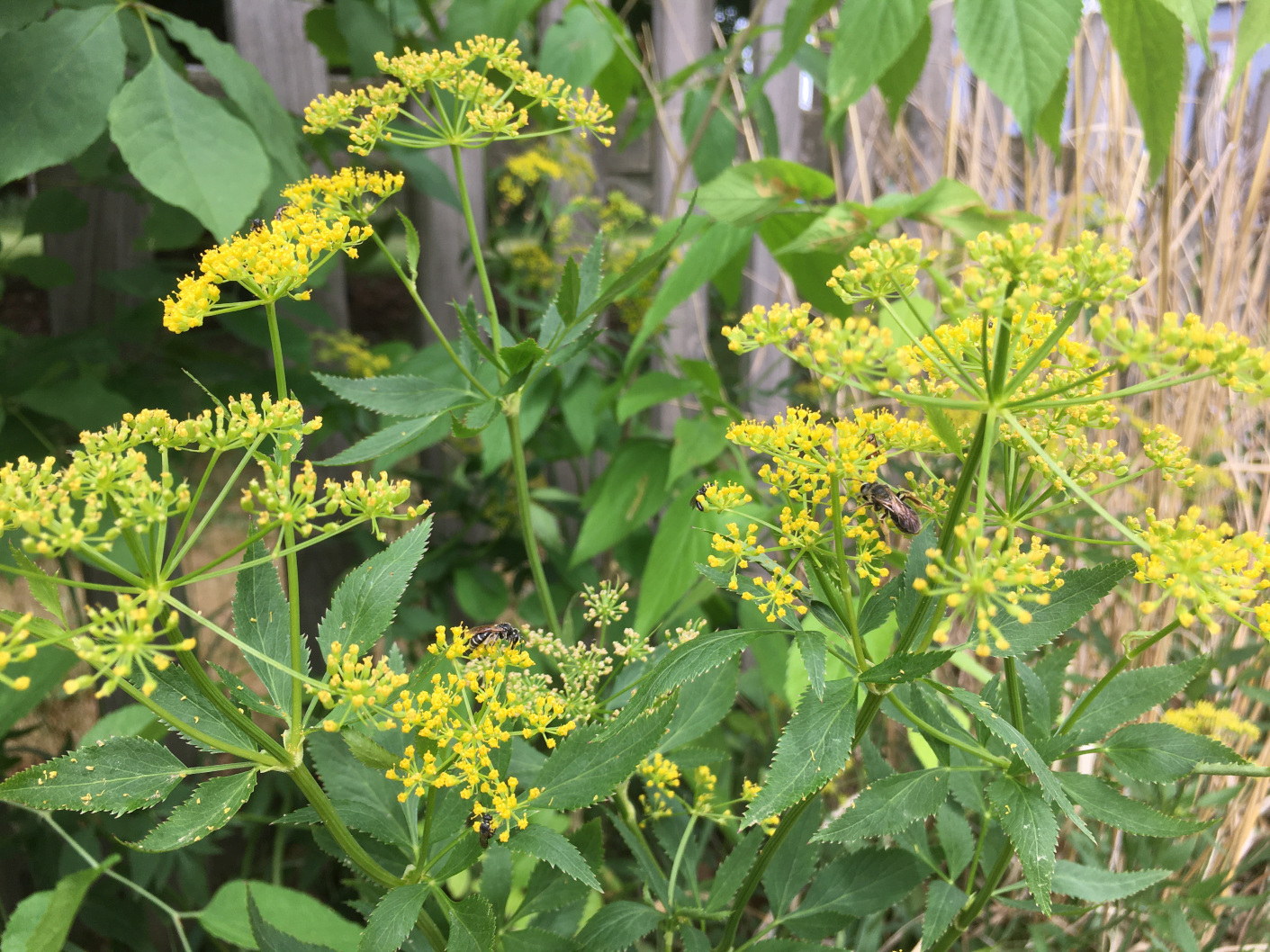
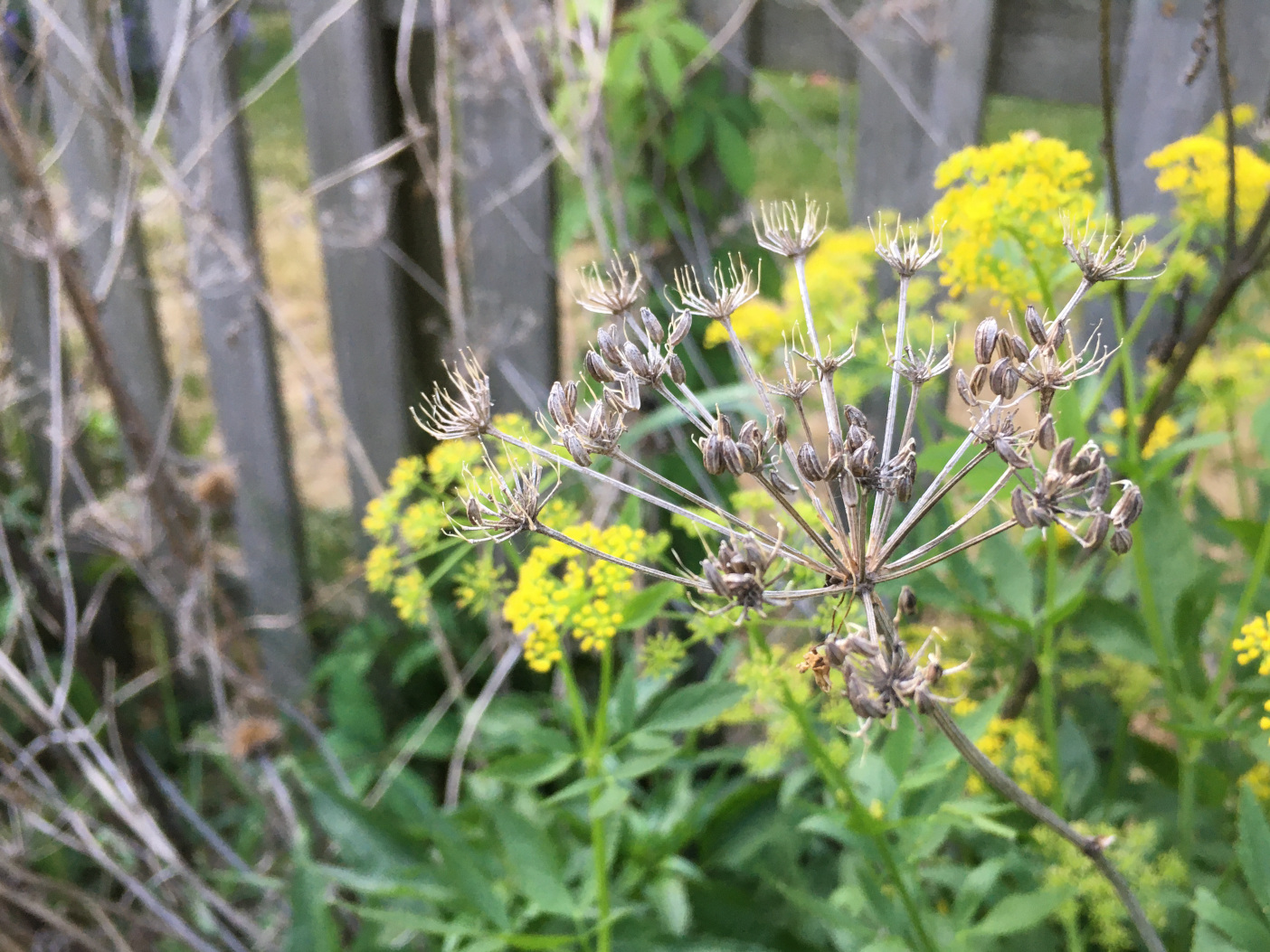
Distribution: Zizia aurea has been documented in 42 Michigan counties, largely in the southern half of the Lower Peninsula, but also in several coastal counties of the Upper Peninsula. Although it seems to occur naturally in wet swampy areas and is generally associated with prairie-like habitats, Golden Alexanders will tolerate a wide range of soil moisture conditions as long as it receives at least partial sunlight.
Blooming period: Depending on the latitude, Golden Alexanders begin to bloom in May and can be seen along the roadside in wet areas and ditches well into the month of June (Photo 4).
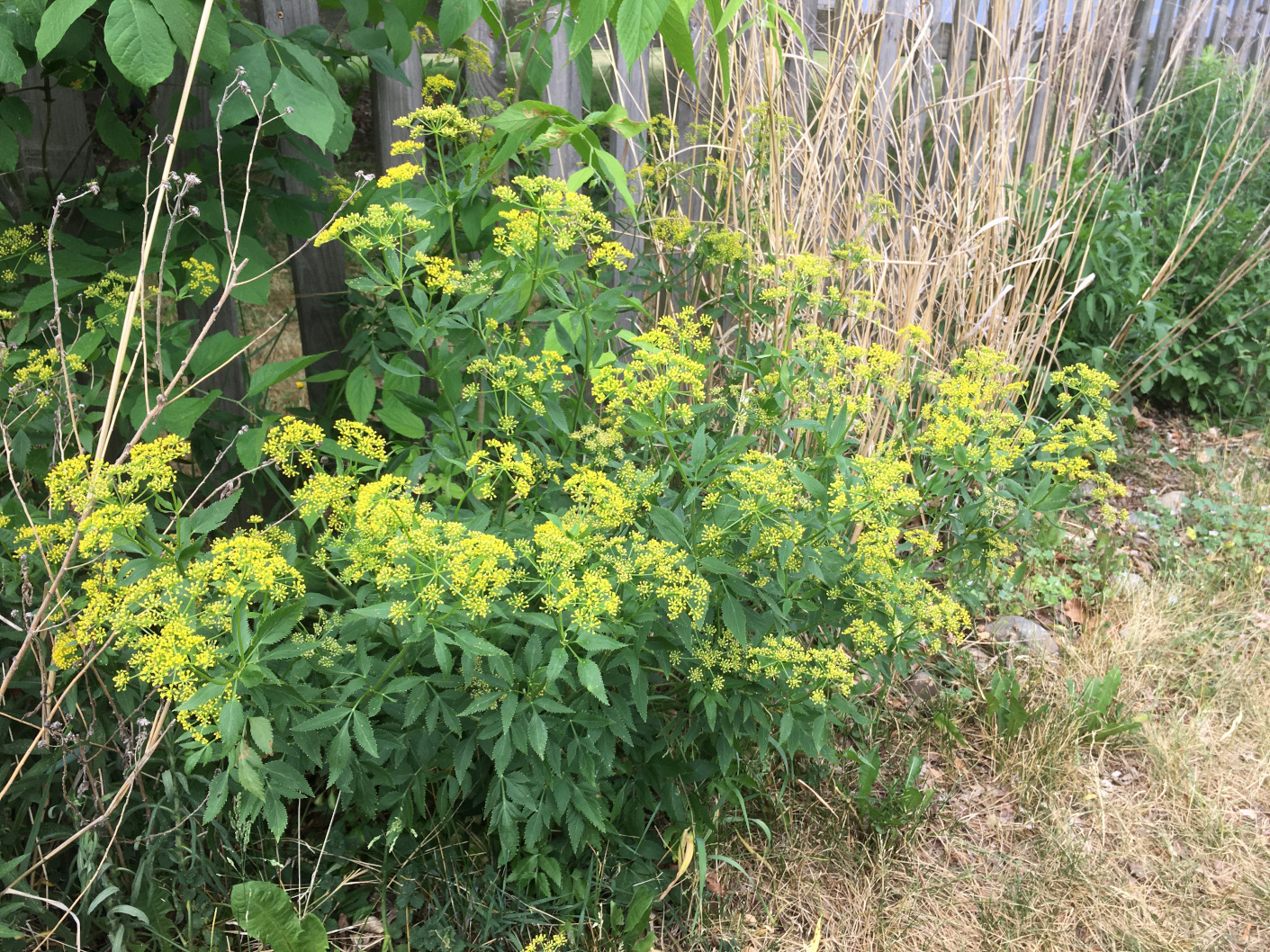
Native status: This species is native to the United States.
Garden uses: Golden Alexanders can be an excellent addition to a wildflower garden. In the author's experience, established specimens will tolerate drier conditions just fine. Young transplants should be watered regularly until they become established and, for that reason, an early to mid-spring planting date is ideal. This species can be aggressive in garden settings where the environment is highly favorable. Annual removal of seedlings may be required to preserve the status quo.
Jeremy's gardening tip: Consider pairing with a variety of catmint (Nepeta racemosa), which blooms at the same time. Not only are they both pollinator favorites, but the yellow and blue flowers compliment each other wonderfully.
Common look-alikes: Meadow parsnip (Thaspium trifoliatum)
Arrowwood viburnum (Viburnum dentatum)
Arrowwood viburnum is a deciduous multi-stemmed shrub that offers seasonal interest in the garden, and on the side of the road. It can grow up to 10 feet tall. There are several cultivars of this species on the market with improved fall color, fruiting and a more compact size.
Description
Flowers: Creamy white flowers borne in clusters about 3 inches in diameter. Flowers look similar to elderberry (Sambucus canadensis), but elderberry has compound leaves with lanceolate leaflets (shaped like the head of a lance).
Leaves: Simple, glossy and hairless leaves with dentate margins (serrate and “tooth-like.”)
Seeds/fruit: Clusters of bluish-black fruit (drupes) that ripen in August.
Height: 5 to 10 feet
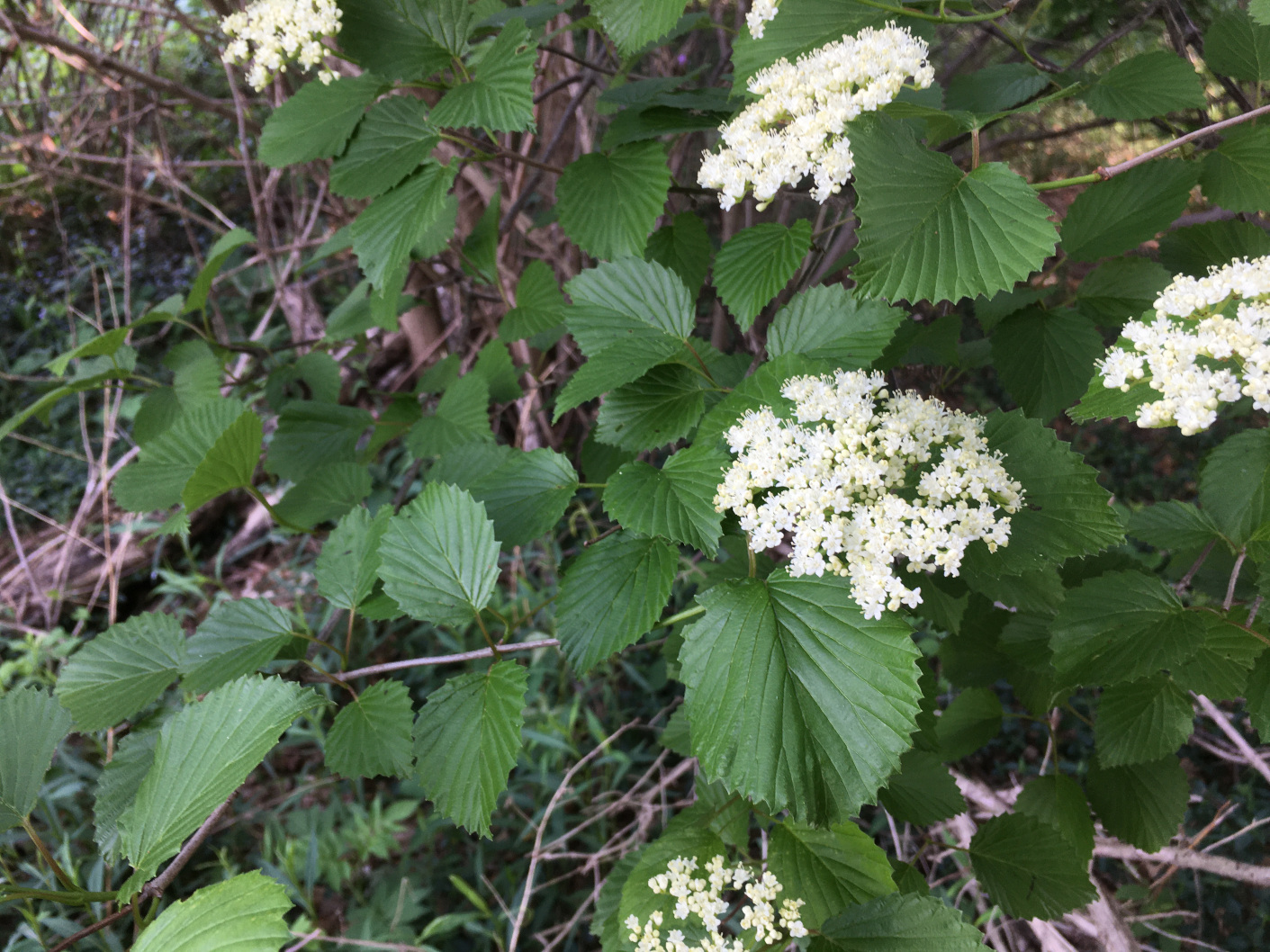
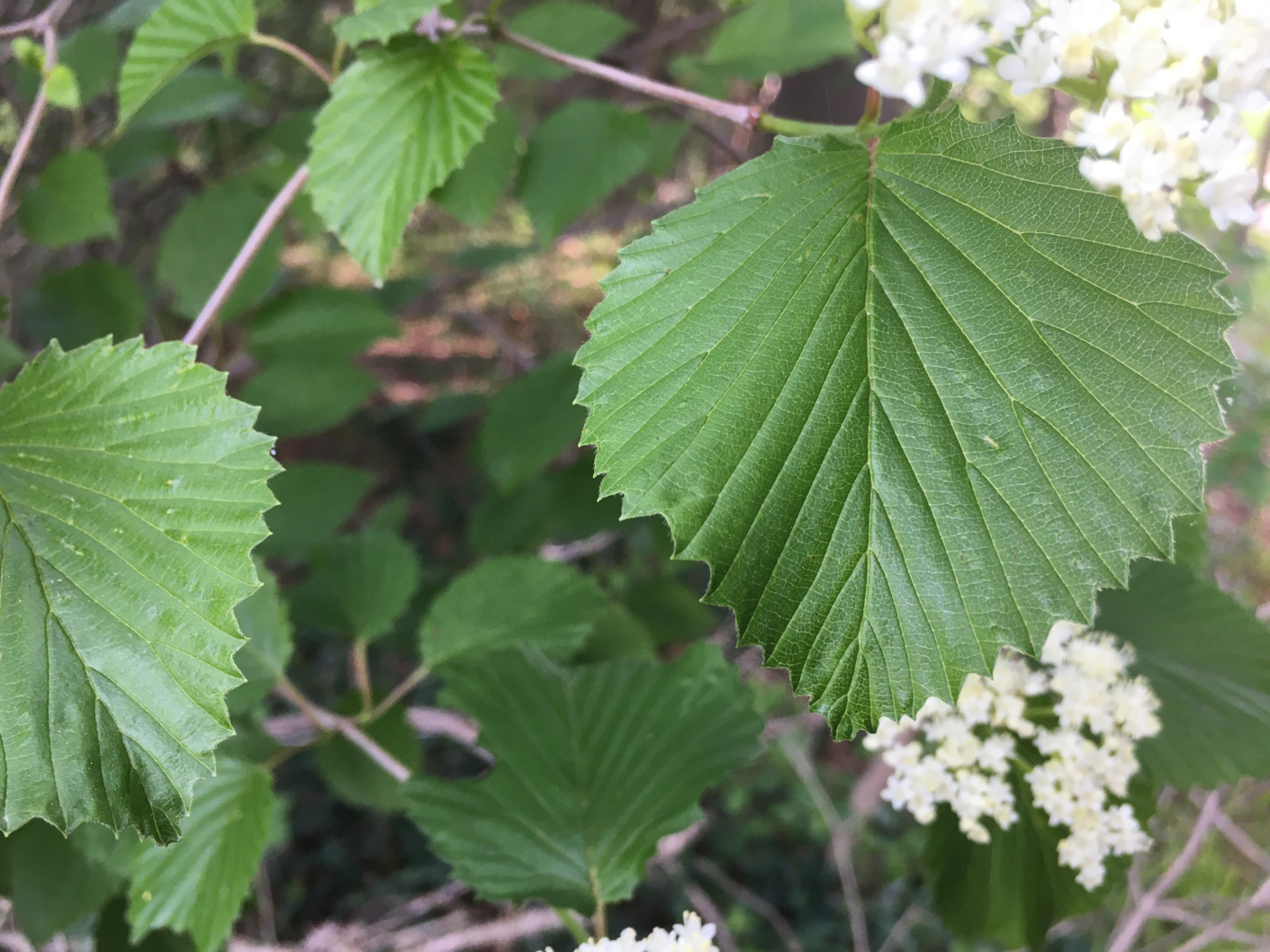
Distribution: Viburnum dentatum has been documented in 24 Michigan counties. This species can be found near marshes, streambanks, along hiking trails and the disturbed areas along the roadside. This is a commonly cultivated shrub in Michigan gardens that grows well in full sun to part shade and in a variety of soils.
Blooming period: Depending on the latitude, this shrub begins to bloom in May and into June. It is one of the later viburnums to bloom.
Native status: This species is native to the United States. In Michigan, it is believed to have occurred naturally in southern part of the state. Northern Michigan populations, as well as some of those near large urban areas in southern Michigan, are likely escapes from cultivation.
Garden uses: Arrowwood viburnum offers interest in the garden throughout the growing season. White flowers in late spring attract pollinators, dark blue clusters of fruit in late summer/fall are a favorite of birds. Two genetically different plants are needed for fruit set. This shrub also has an attractive red fall color.
Isabel’s gardening tip: There are some tradeoffs in various landscape scenarios as arrowwood viburnum is one of the preferred hosts of the viburnum leaf beetle, which can be quick to defoliate a shrub. To avoid this pest, it may be wise to plant a different, less susceptible species of viburnum. More information from Michigan State University Extension: Viburnum leaf beetle now in Michigan.
Common look-alikes: Elderberry (Sambucus canadensis), American highbush cranberry (Viburnum trilobum), Maple-leaved viburnum (Viburnum acerifolium)
Questions? Contact Jeremy Jubenville or Isabel Branstrom with the MSU Extension landscape team.
Thank you to Tyler Bassett from the Michigan Natural Features Inventory for his review of this article.
Resources
- Michigan Flora (2001) – E. Voss



 Print
Print Email
Email





